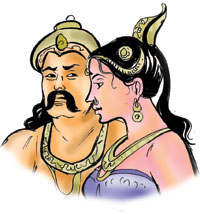1. There is reason for us to believe that the Aryachakaravartis would have descended from the Brahmins of Rameshwaran. They are also connected to the royal family of Gujarat. In Tamil, the word 'Arya' always refers to the North Indians. Going by these facts, scholars are of the opinion, that the Aryas who served the kings of Dambadeniya, would undoubtedly have been Rajputs.
2. Taking all this into consideration, it may be correct to believe in the North Indian origin of Arychakravartitis. Therefore, the Aryachakravartis of South India and the Arya army that served the kings of Dambadeniya, would have been one group of people as some say.
These were a people who were robbed of their land, when the Muslims invaded India. They would have been the 'Rajputs' who drifted to the south and served the Pandya and the Sinhala kings.
3. Whatever be their origin, during the time that we are studying now, a number of generations of Aryachakravartis were
living in the Tamil area. They spoke the Tamil language and respected Tamil culture. According to one of the books in Tamil literature, Aryachakravartis are connected to the 'Ganga' line of kings. It may be through marriage alliances, that the Aryachakravartis claim their connection to the 'Ganga' line of kings of Kalinga.
4. The scholars point out that these marriage alliances would have been with the Javaka kings. The Aryachakravartis had been proud of their connections with Rameshwaram, even after spreading their power in Northern Lanka. They have identified themselves as 'Sethukavalan.' 'Sethu' is another name for Rameshwaram. Even in their inscriptions, they are referred to as 'Sethukavalan.'
5. This same reference could be found in two inscriptions discovered in India and Lanka. They have used the word 'Sethu,' even in their coins.
They state that their capital city was 'Singai Nagar.' This could be Jaffna. In Tamil documents, there is also reference to 'Singai Aryan.' Now if we were to consider the policies of our own kings, it looks as if they carried on a combined rule.
6. This was the policy of Parakramabahu V and Buwanekabahu IV. In one inscription, Parakramabahu V's 15th year of rule is stated as 1218 circa, which is equal to 1359 AD. Accordingly, he has ascended the throne, only three years after Buwanekabahu became king and that is 1344 AD. In another inscription these two kings are referred to as brothers.
7. In a literature book written in the 15th century, it is stated that Parakramabahu V is a son of Vijayabahu V. It further states that the mother of that Parakramabahu was Queen Sumitra. It does not however, state that Buwanekabahu IV too was one of her sons. However, the most efficient minister of both these kings had been Senadhilankara, whose ancestral home was in 'Singuruvana,' close to Gampola.
8. This minister Senadhilankara, in certain other stories is referred to as 'Suhurubandu' of Buwanekabahu IV. The reason for this reference may be because he had got married to a sister of King Buwanekabahu. |


